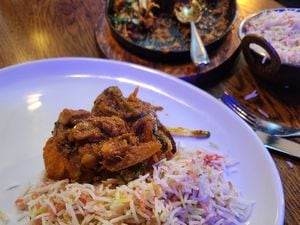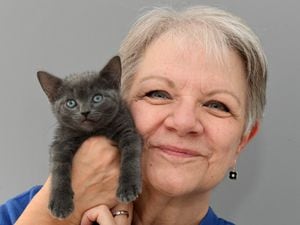Real life: Thorndale's designer bags are totes amazing
A young designer and a ‘rag trade’ veteran are joining forces to create beautiful bags made to last. And they’re doing it in style . . .
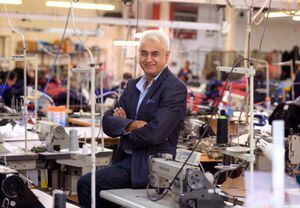
A Wolverhampton company is hoping it has success in the bag with its bold new venture.
It is the result of a meeting of minds between a ‘rag trade’ veteran with around four decades experience in the industry, and a young designer in her first job out of university.
Together they are making a new range of luxury hand-crafted bags with the emphasis on practicality, style and ruggedness.
Using hand-painted high quality leathers, ‘ballistic’ nylon and hard-wearing waxed cotton the company is targeting the increasingly lucrative market for high-end men’s and women’s bags suitable for work, leisure and travel.
They don’t come cheap, with the men’s bags retailing between £369 and £575, while the women’s range from £179-£425, but each one is carefully crafted, hand stitched and comes with its own individually hand-written quality control label.
Daljit Mehat runs LS Manufacturing in Wolverhampton, where his 90-strong workforce work on jobs as wide-ranging as making coat and jackets for top high street brands to curtains for the NHS. The company is also working for the RNLI, turning old lifejackets into a range of bags to be sold in the rescue charity’s shops nationwide.
But the latest venture takes the family firm back to its early days, reviving the Thorndale name first used for a range of ‘thornproof’ waxed jackets back in the late 1950s.
LS Manufacturing was founded 60 years ago by Daljit’s father, Lachman Singh, after he and his wife arrived in Wolverhampton after travelling from the Punjab.
“I still have his pedlar’s and hawker’s licence around somewhere, from when he was selling clothing door to door,” Daljit recalls.
That pedlar’s licence half a century ago allowed Mr Singh to pursue his clothing trade as a sideline to his day job at a local engineering company. He and his wife made the clothes in the front room. They soon needed a factory to house the other workers they needed to take on.
Daljit went to Parkfields School and was there in the 1970s when it had to be closed for urgent, and substantial repairs. “We spent the rest of our school years in Portacabins.” At 18 he chose to join the family business rather than go to college.
“I thought, what will I do once I qualify? Probably come back and work here, so I might as well get on with it,” Mr Mehat recalls. “I’ve never had a proper job, I just came into this. I was selling coats on the old Bilston Market at 13. That was a great laugh.”
Now Daljit’s son and daughter are working at the firm, but it is a tough time for the industry.
At one stage LS was part of a thriving textiles industry in and around Wolverhampton. “There were probably more than 70 firms within a mile of us. Now, 15 years later, there are probably four.
“It’s been challenging. Three years ago we had 150 people, but now we have 90. It’s down to changes in the market; the £1 was quite strong which didn’t make exports from the UK attractive.
“But we have seen a growing attraction for products that are made in Britain, and exports have started growing again with the weaker pound. We have done more exports recently than in the last 10 years, including a large order from South Korea, work from Scandinavia and from the United States. There’s a lot of interest in outerwear and British-made waxed and weatherproof jackets.
“We are now probably one of the UK’s largest independent clothing manufacturers.”
Like most factories in the textile industry most of the workforce are women, with the overwhelming majority from overseas: from India, Pakistan and Eastern Europe.
“We can’t compete against the bottom of the market, the Boohoo.coms of this world. Their prices are just ridiculous from our point of view. We have to go for quality.”
The firm makes coats for major high street brands, but strict rules over confidentiality means they can’t tell anyone. The firm also has its own brands, such as Cro’Jack and John Partridge countrywear.
But around three years ago Daljit started mulling over the idea of making high-end handbags, using the Thorndale name.
He recruited Bridgnorth designer Gina Wilkes virtually straight out of university two years ago. She was joined this summer by Juliette Skorka, the company’s new marketing and social media co-ordinator. She had been working on one of the fashion concessions at House of Fraser’s Beatties store in Wolverhampton after qualifying with a degree in fashion communications from Birmingham City University. The two are now spearheading Thorndale’s push into the marketplace.
Gina studied fashion design at Middlesex University in London and this is her first job in the industry since graduating.
“I’d moved back home to Bridgnorth because it was too expensive to stay living in London after I graduated,” she says.
“I worked in retail for nine months or more while I tried to find a job, but there didn’t seem to be anything around here and I was worried I’d have to give up fashion as a career and try a new direction, or try and save up to try to afford living in London again.
“I almost stumbled across LS Manufacturing when I was job hunting. The job description was a bit vague, because of the confidential nature of the work they do, but when I realised what was involved I was very keen.
“It’s been a wonderful opportunity, to have virtually a free hand – with Daljit’s guidance of course.
“The company had already been looking at producing bags under the Thorndale name but when I came I sat down with Daljit and we decided to start from scratch.
“I wanted to use classic shapes for tote bags, rucksacks and so on, but change the silhouettes, give them a more contemporary look. And I wanted them to be practical, the sort of thing that would be useful for a commuter like the ones I used to see in London on the Underground, to use every day. They needed to have enough room and be hard-wearing.”
The bags were a new venture for both the company and Gina. She had focused on womenswear at university, although she had made a couple of bags for her graduation fashion show.
“I looked at the trends and we did a lot of research around the market; what people wanted and what they used their bags for and so on. So it took quite a while. I joined in May 2015 and started working on the Thorndale project in the September.
“The point at which I really thought we had something was the large holdall, the Haughton. It is one a lot of people are attracted to. I love it. It’s big and practical, hardwearing. The materials look right. It’s sort of the template for what has followed.”
That has included a range of tote bags, backpacks, shoulderbags, expandable holdalls, shoulderbags and clutch bags – the full range can be seen on www.thorndale.co.uk.
“We want them to be wearable and comfortable, and to last. One of the materials we use is a 12-year aged fabric that has already faded from black to brown. All the materials are chosen because they will last and look good as they age.
“And we are now looking at expanding the range even further, with items like washbags. We have our collection and have figured out what works.”
All the styles are named after Staffordshire towns and villages, keeping in touch with the firm’s roots – when it was founded Wolverhampton was still part of the county. And they all have unity of style and approach, using the heavy robust materials and hand-painted leathers.
“We test everything,” says Gina. “We were trying out some of the leathers and found the paint was rubbing off. That was changed straight away.
“I usually have an idea in my head. I’m quite good at holding that vision of the end product in my head while I work on it, drawing the patterns and the initial designs on paper and then transferring them to the materials.”
The hand-made approach requires some serious skills in cutting and stitching the heavyweight materials that are needed.
“We had some initial trouble finding people with the right skills, such as finishing the leathers. Very few people have those skills in the UK now. Most of the firms all over the world do it by machine rather than stitching and finishing by hand.
“But we found some of the workers we already had here, from Eastern Europe and particularly from Poland. did have those skills. Some of them have worked in the leather trade or in tanneries, before coming here.
“One, Brigitte, is in charge of the sampling line where we make the bags by hand.
“She tells me if it can be done. Sometimes I have to change the design because she’ll point out a practical problem in the production process. For instance stitching the leather was an issue because it was so thick it didn’t fit the sewing machine. We had to get another machine to take thin layers off the edges so we could stitch it by hand.
“We adapt our techniques of making the bags to the materials, tweaking as we go. It’s rare that we don’t change something in the process.”
Practicality remains a key focus. The bags are made to be water resistant with strong zips and padding in the pockets that can be used for laptops. “We visualise them as being used for work, for everyday. So the weekend holdall will fit in an overhead locker on a plane. We sent Daljit to Australia with one and it worked perfectly.”
With the long development process behind them, the team is one engaged in online marketing and the bags are already in a few London stores such as Archie Foal, a designer clothing store on the New Kings Road in Fulham, and other shops are showing interest.
Daljit adds: “We’ve had a lot of interest from Japan and also from the US, but that is a market that is just too big for us to service at the moment. We are trying to build up gradually, maintaining control.”
How the team make the cut . . .
Gina will have an idea in her head about the shape and style of the bag, drawing a sketch of what it should look like and then drawing in the pattern shapes on paper.
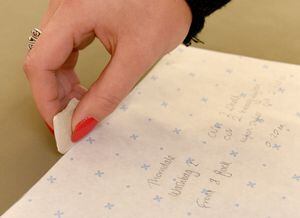
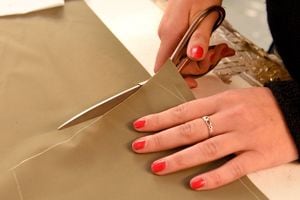
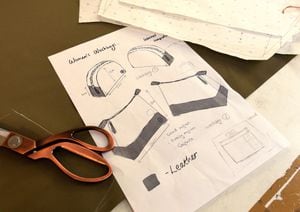
These are cut out and for the first bag she then uses the pattern and chalk to draw outlines on the leathers and other materials that will be used. She and Brigitte will then cut out the material and start assembling the bag, stitching by hand or with a sewing machine.
It’s a long and detailed process and it can take up to a day to make one of the bigger bags from start to finish.


